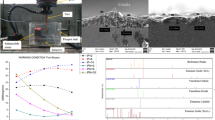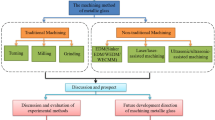Abstract
In this paper, wire electrical discharge machining (WEDM) is used to machine zirconium-based metallic glass. Metallic glass is very sensitive to temperature, and the surface of WEDM will crystallize. For machining defects, multi-cutting methods are used to reduce the impact on the machining of metallic glass. The main research is the effects of different cutting passes on the surface morphology, surface roughness, recast layer thickness, surface microhardness, carbonization, and crystallization of a workpiece. Results show that increasing the cutting passes reduces the size of craters and hard convex edges and produces a smoother surface, and the roughness Ra value is reduced from 3.228 to 0.586 μm. After first cutting, the thickness of the recast layer and the heat-affected zone (HAZ) reached 37.4 μm, and many microcracks appeared in the HAZ. The thickness of the recast layer and the HAZ decreased with the increasing the cutting passes. After the fourth cutting, the thickness of the recast layer and the HAZ decreased by 52% compared with the first cutting, and the surface showed a good amorphous state. Moreover, the WEDM is beneficial to improve the surface microhardness of the zirconium-based metallic glass. The hardness is the highest after the first cutting, and an increase in cutting passes will gradually decrease the surface microhardness. Multi-cutting can effectively improve the surface quality, and this processing method provides an effective method for zirconium-based metallic glass machining applications.








Similar content being viewed by others
References
H. Huang and J. Yan, Multi-Scale Dimple Creation on Metallic Glass by a Two-Step Method Involving Nanoindentation and Polishing, Appl. Surf. Sci., 2018, 462, p 565–574.
L. Zuo, R. Li, Y. Cheng, M. Meng, T. Zhang and A. Inoue, Influence of Laser Surface Melting Treatment on the Surface Composition and Mechanical Properties of a Zr65Al7.5Ni10Cu12.5Ag5 Bulk Metallic Glass, J. Non-Cryst. Solids, 2018, 488, p 63–68.
Z.D. Sha, P.S. Branicio, H.P. Lee and T.E. Tay, Strong and Ductile Nanolaminate Composites Combining Metallic Glasses and Nanoglasses, Int. J. Plast, 2017, 90, p 231–241.
L.M. Andersen, S. Faulhaber, T. Harrington, D.C. Hofmann, H. Cheng and K.S. Vecchio, An Experimental Investigation on the Notch Toughness of Cu-Zr-Based Bulk Metallic Glasses with In-Situ Crystallization, J. Non-Cryst. Solids, 2017, 469, p 70–78.
C. Zhang, N. Qiu, L. Kong, X. Yang and H. Li, Thermodynamic and Structural Basis for Electrochemical Response of Cu–Zr Based Metallic Glass, J. Alloy. Compd., 2015, 645, p 487–490.
Z.D. Sha, S.X. Qu, Z.S. Liu, T.J. Wang and H. Gao, Cyclic Deformation in Metallic Glasses, Nano. Lett., 2015, 15, p 7010–7015.
H. Huang, M. Jiang and J. Yan, Softening of Zr-Based Metallic Glass Induced by Nanosecond Pulsed Laser Irradiation, J. Alloy. Compd., 2018, 754, p 215–221.
X. Yu, J. Huang, L. Shao, Y. Zhang, D. Fan, Y. Kang and F. Yang, Microstructures in the Joint of Zirconium-Based Bulk Metallic Glass and Copper, Mater. Res. Express, 2018, 6, p 2053–1591.
R. Yamada, N. Nomura, J. Saida and A. Kawasaki, Fabrication of Optical Gratings Through Surface Patterning of Zirconium-Based Metallic Glass by Laser Irradiation, Intermetallics, 2018, 93, p 377–382.
Y. Zeng, L. Meng and X. Fang, Surface Characteristics of Ni-Based Metallic Glass in Wire Electrochemical Micro Machining, J. Electrochem. Soc., 2017, 164, p E408–E421.
X.L. Zhang, H.L. Peng, L.Y. Zhang, C.L. Cao, J.W. Yi, Y. Zhou and Y. Zhang, Evolution of White Layer during Wire-Cutting and Comparison of Several Methods to Improve Surface Integrity for Fineblanking Tools, Mater. Sci. Forum, 2018, 920, p 141–148.
H.R. Tonday, A.M. Tigga (2016) Analysis of Effects of Cutting Parameters of Wire Electrical Discharge Machining on Material Removal Rate and Surface Integrity, In: IOP Conference Series: Materials Science and Engineering 115:012013.
L. Selvarajan, C. Sathiya Narayanan and R. Jeyapaul, Optimization of Process Parameters to Improve Form and Orientation Tolerances in EDM of MoSi2-SiC Composites, Mater. Manuf. Process., 2014, 30, p 954–960.
A. Perumal, A. Azhagurajan, S. Baskaran, R. Prithivirajan and P. Narayansamy, Statistical Evaluation and Performance Analysis of Electrical Discharge Machining (EDM) Characteristics of Hard Ti-6Al-2Sn-4Zr-2Mo Alloy, Mater. Res. Express, 2019, 6(5), p 056552.
A.K. Singh, P.K. Patowari and N.V. Deshpande, Analysis of Micro-Rods Machined Using Reverse Micro-EDM, J. Braz. Soc. Mech. Sci. Eng., 2018, 41(1), p 1–12.
M.U. Gaikwad, A. Krishnamoorthy and V.S. Jatti, Investigation and Optimization of Process Parameters in Electrical Discharge Machining (EDM) Process for NiTi 60, Mater. Res. Express, 2019 https://doi.org/10.1088/2053-1591/ab08f3
L. Li, X.T. Wei, Y.B. Guo, W. Li and J.F. Liu, Surface Integrity of Inconel 718 by Wire-EDM at Different Energy Modes, J. Mater. Eng. Perform., 2014, 23, p 3051–3057.
C. Zhang, Study of Small Cracks on Nanocomposite Ceramics Cut by WEDM, Int. J. Adv. Manuf. Technol., 2015, 83, p 187–192.
V. Kumar, K.K. Jangra, V. Kumar and N. Sharma, WEDM of nickel based aerospace alloy: optimization of process parameters and modelling, Int. J. Interact. Des. Manuf. (IJIDeM), 2016, 11, p 917–929.
P.J. Hou, Y.F. Guo, L.X. Sun and G.Q. Deng, Simulation of Temperature and Thermal Stress Filed during Reciprocating Traveling WEDM of Insulating Ceramics, Procedia CIRP, 2013, 6, p 410–415.
A. Goswami and J. Kumar, Trim Cut Machining and Surface Integrity Analysis of Nimonic 80A Alloy Using Wire Cut EDM, Engineering Science and Technology, Int. J., 2017, 20, p 175–186.
K. Chopra, A. Payla and E.K. Mussada, Detailed Experimental Investigations on Machinability of EN31 Steel by WEDM, Trans. Indian Inst. Met., 2019, 72, p 919–927.
A. Kumar, V. Kumar and J. Kumar, Surface Crack Density and Recast Layer Thickness Analysis in WEDM Process Through Response Surface Methodology, Mach. Sci. Technol., 2016, 20, p 201–230.
M. Azam, M. Jahanzaib, J.A. Abbasi, M. Abbas, A. Wasim and S. Hussain, Parametric Analysis of Recast Layer Formation in Wire-Cut EDM of HSLA Steel, Int. J. Adv. Manuf. Tech., 2016, 87, p 713–722.
K. Mouralova, J. Kovar, L. Klakurkova and T. Prokes, Effect of Width of Kerf on Machining Accuracy and Subsurface Layer After WEDM, J. Mater. Eng. Perform., 2018, 27, p 1908–1916.
W. Wang, Z.D. Liu, W.T. Shi, Y.Q. Zhang and Z.J. Tian, Surface Burning of High-Speed Reciprocating Wire Electrical Discharge Machining Under Large Cutting Energy, Int. J. Adv. Manuf. Tech., 2016, 87, p 2713–2720.
P. Sharma, A. Dhawan, S.K (2016) Sharma, Surface morphology study of Zr-based amorphous alloys after immersion in boiling nitric acid medium.
N. Vermaak, G. Parry, R. Estevez and Y. Bréchet, New Insight into Crack Formation During Corrosion of Zirconium-Based Metal-Oxide Systems, Acta Mater., 2013, 61, p 4374–4383.
C. Kato, Y. Ishijima, T. Motooka et al., Influence of Oxide Film to Stress Corrosion Cracking of Zirconium in Boiling Nitric Acid Solution[J], J. Zool., 2009, 205(3), p 373–383.
H. Huang and J. Yan, Microstructural Changes of Zr-Based Metallic Glass During Micro-Electrical Discharge Machining and Grinding by a Sintered Diamond Tool, J. Alloy. Compd., 2016, 688, p 14–21.
Acknowledgments
This work was supported by the National Natural Science Foundation of China (No. U19A20103), the China Postdoctoral Science Foundation (No. 2019M661184), and the “111” Project of China (No. D17017).
Author information
Authors and Affiliations
Corresponding authors
Additional information
Publisher's Note
Springer Nature remains neutral with regard to jurisdictional claims in published maps and institutional affiliations.
Rights and permissions
About this article
Cite this article
Hou, Y., Xu, J., Lian, Z. et al. Surface Integrity Evolution of Zirconium-Based Metallic Glass Multi-Cut with Wire Electrical Discharge Machining. J. of Materi Eng and Perform 31, 4158–4166 (2022). https://doi.org/10.1007/s11665-021-06518-1
Received:
Revised:
Accepted:
Published:
Issue Date:
DOI: https://doi.org/10.1007/s11665-021-06518-1




